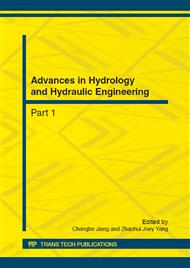[1]
Jianyi Lu. Effect of sediment transport condition deposition and stretching of the Yellow River Estuary [J]. The Ocean Engineering, 1985, 3(2): 51-64. (In Chinese)
Google Scholar
[2]
Houjie Wang, Zuosheng Yang, Haidong Li et al. 3-D simulation of the suspended sediment transport in the Yellow River mouth II: Application to the double-dyke project [J]. Journal of Sediment Research, 2006(2): 29-36. (In Chinese)
Google Scholar
[3]
Qinghua Zeng, Shiqi Zhang, Chunhong Hu et al. The Yellow River Estuary evolution law and regulation [M]. Zhengzhou: Yellow River Hydraulic Press, 1998. (In Chinese)
Google Scholar
[4]
Jun Chang, Gaohuan Liu, Qingsheng Liu. Analysis on spatio-temporal feature of coastline change in the Yellow River Estuary and its relation with runoff and sand-transportation [J]. Geographical Research, 2004, 23(5): 339-346. (In Chinese)
Google Scholar
[5]
Chunhong Hu, Zhihao Zhang. Evolution and control of estuary sandbar in Yellow River responding to variation of flow-sediment condition [J]. Journal of Hydraulic Engineering, 2006, 37(5): 511-518. (In Chinese)
Google Scholar
[6]
Kairong Wang, Yuying Ru, Xiaotian Chen et al. Discussion on the dynamic equilibrium problem of the delta coastline of the Yellow River Estuary [J]. Journal of Sediment Research, 2007(6): 66-70. (In Chinese)
Google Scholar
[7]
Wenhong Cao. Sediment transportation rule and change mechanism of the Yellow River Estuary and shoreline and wetland study [D]. Beijing: Graduate School, China Institute of Water Resources and Hydropower Research, 1999. (In Chinese)
Google Scholar
[8]
Shiqi Zhang. Analysis on sediment transporting capacity by sea power in the Yellow River Estuary [J]. Journal of Sediment Research, 2007(1): 8-16. (In Chinese)
Google Scholar
[9]
Chonghao Wang, Wenhong Cao, Shiqi Zhang. Tidal current and its sediment transport capacity in Yellow River Estuary [J]. Journal of Hydraulic Engineering, 2008, 39(10): 1256-1263. (In Chinese)
Google Scholar
[10]
Chunhong Hu, Zuwen Ji, Tao Wang. Characteristics of ocean dynamic and sediment diffusion in the Yellow River Estuary [J]. Journal of Sediment Research, 1996(4): 1-10. (In Chinese)
Google Scholar
[11]
Nianhu Dong. Distribution of deposited sediments in Qingshuigou Channel of the Yellow River and diffusion of the sediments in to sea [J]. Journal of Oceanography of Huanghai & Bohai Seas, 1997, 15(2): 33-37. (In Chinese)
Google Scholar
[12]
Wenyong Gao, Guangquan Zhang, Mingxing Jiang, et al. Fluvial process for the Qingshuigou river course of the Yellow River Estuary [J]. Journal of Sediment Research, 1997(3): 1-7. (In Chinese)
Google Scholar
[13]
Jiazhen Pang, Shuting Si. Fluvial process of the Huanghe River Estuary III. Influence of the evolution of the Huanghe River Estuary on the lower reach [J]. Oceanologia et Limnologia Sinica, 1982, 13(3): 218-224. (In Chinese)
DOI: 10.1007/bf02851492
Google Scholar
[14]
Chunhong Hu, Wenhong Cao. Variation, regulation and control of flow and sediment in the Yellow River Estuary I: Regulation Countermeasures [J]. Journal of Sediment Research, 2003(5): 1-8. (In Chinese)
Google Scholar
[15]
Jiazhen Pang, Shuting Si. Fluvial process of the Huanghe River Estuary II. Hydrographycial character and the region of sediment silting [J]. Oceanologia et Limnologia Sinica, 1980, 11(4): 295-305. (In Chinese)
Google Scholar
[16]
Zegang Li. Scouring and depositing change of the Yellow River Estuary channel and its extending influence [J]. Yellow River, 1992, 14(5): 25-29. (In Chinese)
Google Scholar
[17]
Zegang Li, Wanzhan Wang. Thinking and methods of keeping the Yellow River route entering sea stable [J]. Yellow River, 2009, 31(8): 13-15. (In Chinese)
Google Scholar
[18]
Yuying Ru, Jie Liu, Qiwu Zhu et al. Characteristics of runoff and sediment variations of the Yellow River Mouth [J]. Yellow River, 2005, 27(1): 28-31. (In Chinese)
Google Scholar
[19]
Yuying Ru, Kairong Wang, Zhijun Hou. Response of the reach near the Yellow River Estuary to the operation of Xiaolangdi Reservoir [J]. Journal of Sediment Research, 2008(3): 63-68. (In Chinese)
Google Scholar
[20]
Mingli Shi, Wenyi Yao, Yong Li. Scouring and depositing of the Yellow River Lower Reach and Estuary in the initial stage of Xiaolangdi Reservoir sediment-hindering application [R]. Zhengzhou, the Yellow River Institute of Hydraulic Research, 2011. (In Chinese)
Google Scholar


